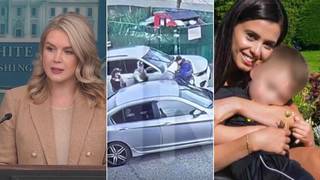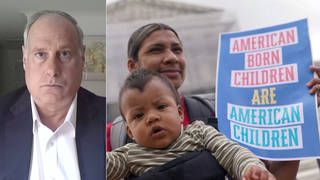
The U.S. Supreme Court on Thursday struck down a century-old New York state law that limited who can carry concealed weapons in public, with Justice Clarence Thomas writing for the 6-3 majority that the statute violated the Second Amendment’s right to bear arms. The ruling vastly expands gun rights in the U.S. just weeks after mass shootings in Buffalo, New York, and Uvalde, Texas, and represents “a revolution in Second Amendment law,” says Slate senior writer Mark Joseph Stern. “It declares that any restriction on the right to self-defense is presumptively unconstitutional.” In light of the Supreme Court decision, a bipartisan gun violence bill passed by the Senate is “one step forward, two steps back.” Stern also discusses a separate ruling in which the court’s conservative majority said a person who is arrested and not told of their right to remain silent cannot subsequently sue police for violating their Fifth Amendment rights against self-incrimination — even if statements they give are ultimately used against them at trial. The decision could be setting the stage for the court to overturn the 1966 Miranda v. Arizona precedent altogether, Stern warns.
Transcript
AMY GOODMAN: It’s been one month since the May 24th massacre at Robb Elementary School in Uvalde, Texas, when an 18-year-old gunman killed 19 fourth graders and two teachers. Just 10 days before, a white supremacist 18-year-old wearing body armor, carrying an assault rifle, opened fire on a supermarket in the heart of Buffalo, New York’s African American community, killing 10 people. Of the 13 shoppers and store workers shot in the assault, 11 were Black.
In response, thousands of people took to the streets across the country to continue to demand the Biden administration enact federal gun control laws. Well, on Thursday, the U.S. Senate approved a bipartisan gun safety bill by a vote of 65 to 33. It’s the first time in decades the Senate agreed to new gun legislation. This is Senate Majority Leader Chuck Schumer.
MAJORITY LEADER CHUCK SCHUMER: This is not a cure-all for all the ways gun violence affects our nation, but it is a long-overdue step in the right direction. Passing this gun safety bill is truly significant, and it’s going to save lives.
AMY GOODMAN: Measures in the bill include expanded background checks for people under the age of 21 and financial incentives for states to pass red flag laws. The Senate bill, however, does not include a number of gun control initiatives that were included in a recent bill approved by House Democrats which aimed to ban the sale of large-capacity magazines and raise the minimum age to purchase an assault weapon from 18 to 21. The Buffalo and Uvalde gunmen were both 18 years old. The Democratic-led House is expected to take up the bill today to send to President Biden’s desk.
The Senate’s vote came just hours after the Supreme Court struck down a century-old New York law that limited the carrying of concealed handguns outside the home. The court’s ruling, 6 to 3. Five other states have similar laws that are now in jeopardy: California, Hawaii, Maryland, Massachusetts and New Jersey. In the majority opinion, Justice Clarence Thomas wrote the Second Amendment, quote, “protects an individual’s right to carry a handgun for self-defense outside the home.”
The ruling is seen as a major setback for gun control efforts following the recent mass shootings in Buffalo and Uvalde. New York Governor Kathy Hochul blasted the ruling.
GOV. KATHY HOCHUL: This decision isn’t just reckless. It’s reprehensible. It’s not what New Yorkers want. And we should have the right of determination of what we want to do in terms of our gun laws in our state.
AMY GOODMAN: Retiring Justice Stephen Breyer wrote in his dissent, quote, “Many states have tried to address some of the dangers of gun violence just described by passing laws that limit, in various ways, who may purchase, carry, or use firearms of different kinds. The Court today severely burdens States’ efforts to do so,” unquote.
Meanwhile, Supreme Court lawyer and former U.S. acting Solicitor General Neal Katyal tweeted, “Gonna be very weird if Supreme Court ends a constitutional right to obtain an abortion next week, saying it should be left to the States to decide, right after it just imposed a constitutional right to concealed carry of firearms, saying it cannot be left to the States to decide.”
Well, for more, we’re joined in New York by Mark Joseph Stern, senior writer at Slate covering the U.S. Supreme Court, federal, appellate, district, state and local courts. His latest piece is headlined “Clarence Thomas’ Maximalist Second Amendment Ruling Is a Nightmare for Gun Control.”
Welcome to Democracy Now!, Mark. So, can you just lay out this ruling for us?
MARK JOSEPH STERN: Yes. So, Justice Clarence Thomas’s opinion for the court really works a revolution in Second Amendment law. It declares that any restriction on the right to self-defense is presumptively unconstitutional and that the only way a state can save its gun restriction is if it can pinpoint some historical analogue that not only existed but was common in either 1791, when the Second Amendment was ratified, or 1868, when the 14th Amendment was ratified, applying the Second Amendment to the states. Of course, those were very different times from today. To give one example, there were not subways back then. And so, when states look to, say, limit the carrying of guns on subways, they will now be severely burdened, if not totally disarmed, so to speak, because they cannot look back to history to satisfy Thomas’s new and very stringent test.
AMY GOODMAN: So, explain where — what the maximalist stance of Clarence Thomas is.
MARK JOSEPH STERN: So, Justice Thomas writes that the Second Amendment is different from other rights in that the courts cannot look at the real-world impact of gun violence when assessing the legality of gun restrictions. This is very different from every other right. When we look at free speech, the right against unreasonable searches, the court always balances interests. It asks whether the government has a compelling interest, whether it has tailored its restriction to further that interest, and it looks at how the government’s actions have actually addressed the problem that it seeks to solve.
In this decision, Clarence Thomas says all of that is off the table in Second Amendment cases. Judges are simply prohibited from considering any kind of empirical evidence about how gun restrictions or gun laws have an effect on the real world, including whether certain gun laws happen to protect our communities and individuals from gun violence. He says that’s irrelevant to the Constitution. It doesn’t matter if these laws save lives or not; all that matters is whether a state can prove that the framers of the Second or 14th Amendment would have greenlighted that law. And if you can’t kind of hold a séance with those framers and prove to Clarence Thomas’s satisfaction that they would have been OK with what you’re trying to do, then your gun law will be struck down by the federal judiciary.
AMY GOODMAN: Talk about what the New York law, the century-old New York law, was.
MARK JOSEPH STERN: So, the New York law restricted who could carry a concealed weapon in public places, and held that in order to get such a permit, you had to show some kind of heightened need for self-defense. You couldn’t just say, “I am scared of other people and want to be able to shoot them if they attack me.” You had to show that, for instance, you had a stalker; you were a victim of abuse. And that’s very similar to other states’ laws, like California, like Maryland, near where I live.
But in this decision, Clarence Thomas said, “Well, those laws are historical anomalies. And, in fact, for much of American history, individuals have had a guaranteed right to carry firearms in public that the government cannot take away without a very good compelling reason.”
To support that argument, he cherry-picked a lot of history and actually ignored a number of data points that show that in the 18th century and 19th century American states restricted guns a lot more than we usually assume today. If you entered a town in the American West carrying a gun, you may well have been kicked out. If you tried to carry a gun in the streets of a city when the Constitution was ratified, you may well have been arrested. But Thomas is not a real historian; he is an amateur. And so he deploys this kind of dilettante analysis to exclude every single fact that’s not convenient for his conclusion and only focus on those states that had more liberal gun laws and use those to leverage against New York’s current law, which, as you said, is a century old, to claim that it’s an anomaly and cannot stand under the Second Amendment.
AMY GOODMAN: So, can you talk now about what this means? We’re talking about five other states who have similar laws to New York. And the irony of this coming on the very day that the Senate, which does not want to pass any gun control — at least the Republicans do not — in the Senate, did pass very limited gun control legislation?
MARK JOSEPH STERN: Well, it feels like one step forward, two steps back to me. I think that the Senate bill is very good for what it does. It’s important to increase scrutiny of gun buyers under 21, who are statistically far more likely to commit violent crime. It’s good to increase incentives for red flag laws.
But there is also a lot of evidence that shows that more permissive concealed-carry regimes, like the one that the Supreme Court just forced on New York, lead to an increase in gun homicides and an increase in overall violence within a state. There is, meanwhile, essentially no evidence that these permissive concealed-carry laws protect individuals from violence or help victims of crimes. You can seek out individual anecdotes in which someone used a gun to protect themselves, but if you look at the broader level, if you look at the state population, individuals are far more likely to be murdered with a concealed weapon for no good reason than they are to protect themselves with one.
So, while I think the Senate bill will certainly save lives, I think the Supreme Court’s decision will cost lives. And it’s especially sad because states like New York, Hawaii, Maryland are doing a lot of good in tackling gun violence. And this decision just withdraws from the public sphere, from the democratic debate, one of the single most important tools that a state previously had to reduce the rates of gun homicides within its borders.
AMY GOODMAN: Finally, Mark, before we go, I mean, gun control — lifting the gun ban and imposing an abortion ban, essentially, are the two big cases everyone’s looking for. But there have been other rulings. Can you talk about the piece you wrote about — in your piece headlined “Alito’s Attack on Miranda Warnings Is Worse Than It Seems.”
MARK JOSEPH STERN: Yes. So, Justice Alito’s opinion for the court in this decision held that receiving Miranda warnings — the right to remain silent, the right to have a lawyer — we’ve all seen it on TV and crime shows — that that right is not actually rooted in the Constitution and that it is a court-made right, and so when it is violated, victims have no redress. They cannot sue in court. They cannot seek some kind of remedy, even if they are wrongfully convicted on the basis of a Miranda violation.
And his opinion contains language that suggests that the court may outright overrule the Miranda decision from 1965. If the court takes that step, it will usher in a new era of coerced and involuntary confessions, many of which are unreliable or outright false, and knock down one of the few remaining safeguards that protects criminal suspects from abusive and coercive tactics when they’re taken into custody and interrogated.
AMY GOODMAN: Mark Joseph Stern, I want to thank you so much for being with us, senior writer at Slate. And we’ll link to the pieces that you write there.
Next up, the House Select Committee to Investigate the January 6th Attack on the Capitol reveals new details about Donald Trump’s efforts to subvert the 2020 election. Stay with us.













Media Options